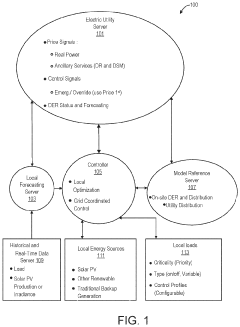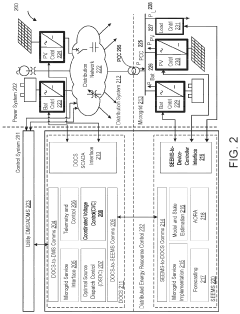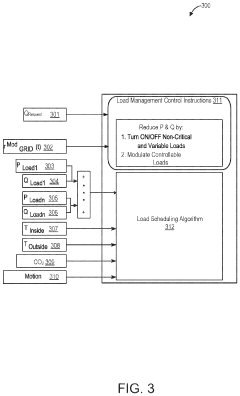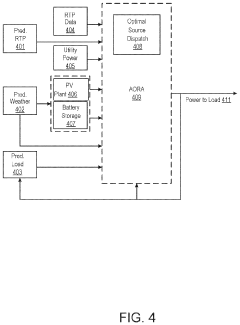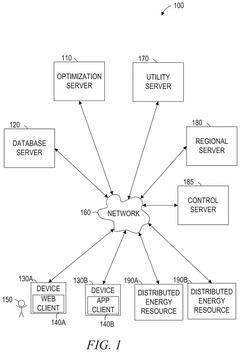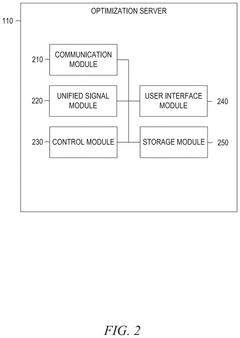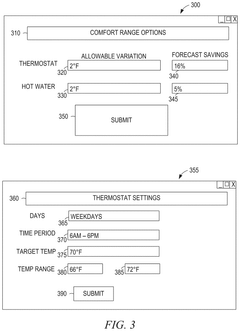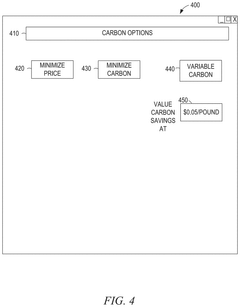Throttle Body Optimization for Distributed Energy Resources (DERs)
JUL 18, 20259 MIN READ
Generate Your Research Report Instantly with AI Agent
Patsnap Eureka helps you evaluate technical feasibility & market potential.
DER Throttle Body Evolution
The evolution of throttle body technology for Distributed Energy Resources (DERs) has been marked by significant advancements in response to the growing demand for more efficient and flexible energy management systems. Initially, throttle bodies in DERs were simple mechanical devices used to control the flow of air or fuel. These early designs were often imprecise and lacked the ability to respond quickly to changing energy demands.
As DERs became more prevalent in the energy landscape, the need for more sophisticated throttle body systems became apparent. The second generation of throttle bodies introduced electronic control mechanisms, allowing for more precise adjustments and improved response times. This marked a significant leap forward in the ability to manage energy flow and optimize resource utilization.
The third generation saw the integration of smart sensors and advanced control algorithms. These innovations enabled throttle bodies to adapt in real-time to varying load conditions and energy availability. This adaptive capability greatly enhanced the overall efficiency of DER systems and contributed to their increased adoption in both residential and commercial applications.
Recent developments have focused on the incorporation of predictive analytics and machine learning algorithms into throttle body control systems. These cutting-edge technologies allow for proactive adjustments based on anticipated energy demand patterns and environmental factors. This predictive capability has further improved the efficiency and reliability of DER systems.
The latest evolution in throttle body technology for DERs involves the integration of Internet of Things (IoT) connectivity. This advancement enables throttle bodies to communicate with other components of the energy system and even with external data sources. The result is a highly interconnected and responsive energy management ecosystem that can optimize performance across multiple DERs and adapt to broader grid conditions.
Looking ahead, the future of throttle body technology in DERs is likely to focus on further miniaturization, increased durability, and enhanced integration with renewable energy sources. Researchers are exploring the use of advanced materials and manufacturing techniques to create more compact and efficient throttle bodies that can withstand the rigors of continuous operation in diverse environmental conditions.
As DERs became more prevalent in the energy landscape, the need for more sophisticated throttle body systems became apparent. The second generation of throttle bodies introduced electronic control mechanisms, allowing for more precise adjustments and improved response times. This marked a significant leap forward in the ability to manage energy flow and optimize resource utilization.
The third generation saw the integration of smart sensors and advanced control algorithms. These innovations enabled throttle bodies to adapt in real-time to varying load conditions and energy availability. This adaptive capability greatly enhanced the overall efficiency of DER systems and contributed to their increased adoption in both residential and commercial applications.
Recent developments have focused on the incorporation of predictive analytics and machine learning algorithms into throttle body control systems. These cutting-edge technologies allow for proactive adjustments based on anticipated energy demand patterns and environmental factors. This predictive capability has further improved the efficiency and reliability of DER systems.
The latest evolution in throttle body technology for DERs involves the integration of Internet of Things (IoT) connectivity. This advancement enables throttle bodies to communicate with other components of the energy system and even with external data sources. The result is a highly interconnected and responsive energy management ecosystem that can optimize performance across multiple DERs and adapt to broader grid conditions.
Looking ahead, the future of throttle body technology in DERs is likely to focus on further miniaturization, increased durability, and enhanced integration with renewable energy sources. Researchers are exploring the use of advanced materials and manufacturing techniques to create more compact and efficient throttle bodies that can withstand the rigors of continuous operation in diverse environmental conditions.
Market Demand for DERs
The market demand for Distributed Energy Resources (DERs) has been experiencing significant growth in recent years, driven by various factors including the push for cleaner energy, grid resilience, and energy independence. As the global energy landscape shifts towards decentralization, DERs are becoming increasingly crucial in meeting the evolving needs of consumers and utilities alike.
One of the primary drivers of DER market demand is the growing emphasis on renewable energy integration. Governments and organizations worldwide are setting ambitious targets for reducing carbon emissions, leading to a surge in the adoption of solar panels, wind turbines, and other renewable energy sources. These distributed generation technologies require efficient management systems, creating a robust market for DER optimization solutions.
The increasing frequency of extreme weather events and natural disasters has highlighted the importance of grid resilience. Consumers and businesses are seeking ways to ensure uninterrupted power supply, even during grid outages. This has led to a rising demand for microgrids and energy storage systems, which are integral components of the DER ecosystem. The ability to operate independently from the main grid during emergencies has become a valuable proposition, driving investment in DER technologies.
Energy cost reduction is another significant factor fueling the demand for DERs. As electricity prices continue to rise in many regions, consumers and businesses are looking for ways to reduce their energy bills. DERs offer the potential for on-site generation, demand response, and energy efficiency improvements, all of which can lead to substantial cost savings over time. This economic incentive has been particularly attractive for commercial and industrial customers, who often have high energy consumption and can benefit greatly from optimized energy management.
The electrification of transportation is also contributing to the growing demand for DERs. As electric vehicles (EVs) become more prevalent, there is an increasing need for charging infrastructure that can be integrated with existing power systems. DERs play a crucial role in managing the additional load on the grid and can potentially use EVs as mobile energy storage units, further enhancing grid flexibility and stability.
Utilities and grid operators are recognizing the value of DERs in managing peak demand and improving overall grid efficiency. By leveraging DERs, they can defer costly infrastructure upgrades and better balance supply and demand. This has led to the development of virtual power plants (VPPs) and other aggregation models that allow for the coordinated control of multiple DERs, creating new market opportunities for technology providers and energy service companies.
As the Internet of Things (IoT) and advanced analytics continue to evolve, the demand for sophisticated DER management systems is also on the rise. These systems enable real-time monitoring, predictive maintenance, and optimized performance of distributed energy assets, enhancing their value proposition and driving further market growth.
One of the primary drivers of DER market demand is the growing emphasis on renewable energy integration. Governments and organizations worldwide are setting ambitious targets for reducing carbon emissions, leading to a surge in the adoption of solar panels, wind turbines, and other renewable energy sources. These distributed generation technologies require efficient management systems, creating a robust market for DER optimization solutions.
The increasing frequency of extreme weather events and natural disasters has highlighted the importance of grid resilience. Consumers and businesses are seeking ways to ensure uninterrupted power supply, even during grid outages. This has led to a rising demand for microgrids and energy storage systems, which are integral components of the DER ecosystem. The ability to operate independently from the main grid during emergencies has become a valuable proposition, driving investment in DER technologies.
Energy cost reduction is another significant factor fueling the demand for DERs. As electricity prices continue to rise in many regions, consumers and businesses are looking for ways to reduce their energy bills. DERs offer the potential for on-site generation, demand response, and energy efficiency improvements, all of which can lead to substantial cost savings over time. This economic incentive has been particularly attractive for commercial and industrial customers, who often have high energy consumption and can benefit greatly from optimized energy management.
The electrification of transportation is also contributing to the growing demand for DERs. As electric vehicles (EVs) become more prevalent, there is an increasing need for charging infrastructure that can be integrated with existing power systems. DERs play a crucial role in managing the additional load on the grid and can potentially use EVs as mobile energy storage units, further enhancing grid flexibility and stability.
Utilities and grid operators are recognizing the value of DERs in managing peak demand and improving overall grid efficiency. By leveraging DERs, they can defer costly infrastructure upgrades and better balance supply and demand. This has led to the development of virtual power plants (VPPs) and other aggregation models that allow for the coordinated control of multiple DERs, creating new market opportunities for technology providers and energy service companies.
As the Internet of Things (IoT) and advanced analytics continue to evolve, the demand for sophisticated DER management systems is also on the rise. These systems enable real-time monitoring, predictive maintenance, and optimized performance of distributed energy assets, enhancing their value proposition and driving further market growth.
Throttle Body Challenges
The optimization of throttle bodies for Distributed Energy Resources (DERs) faces several significant challenges that need to be addressed for effective implementation. One of the primary obstacles is the dynamic nature of DER systems, which require throttle bodies to adapt quickly to varying energy demands and supply conditions. This adaptability is crucial for maintaining system stability and efficiency, but it puts considerable strain on the throttle body's mechanical components and control systems.
Another major challenge lies in the diverse range of DER technologies and their unique operational characteristics. Throttle bodies must be designed to accommodate different types of energy sources, such as solar panels, wind turbines, and energy storage systems, each with its own specific requirements for flow control and response times. This diversity complicates the development of standardized throttle body solutions and necessitates a more flexible and modular approach to design.
The integration of advanced sensors and control algorithms presents another hurdle in throttle body optimization. While these technologies offer the potential for more precise and responsive throttle control, they also introduce complexity in terms of system architecture, data processing, and reliability. Ensuring the seamless integration of these smart components with existing DER infrastructure is a significant challenge that requires careful consideration of compatibility and interoperability issues.
Efficiency and energy loss reduction remain critical challenges in throttle body design for DERs. As these systems often operate at varying loads and conditions, maintaining high efficiency across a wide operational range is essential. This necessitates innovative approaches to throttle body geometry, materials, and actuation mechanisms to minimize pressure drops and energy losses while ensuring rapid and accurate flow control.
Environmental factors and durability concerns also pose significant challenges. Throttle bodies in DER applications may be exposed to harsh conditions, including extreme temperatures, humidity, and corrosive environments. Developing robust designs that can withstand these conditions while maintaining long-term reliability and performance is crucial for the widespread adoption of optimized throttle bodies in DER systems.
Lastly, cost-effectiveness and scalability present ongoing challenges in throttle body optimization. As DERs continue to grow in popularity and scale, there is a pressing need for throttle body solutions that are not only high-performing but also economically viable for mass production and deployment. Balancing advanced features and materials with cost considerations remains a key challenge for manufacturers and system integrators in the DER space.
Another major challenge lies in the diverse range of DER technologies and their unique operational characteristics. Throttle bodies must be designed to accommodate different types of energy sources, such as solar panels, wind turbines, and energy storage systems, each with its own specific requirements for flow control and response times. This diversity complicates the development of standardized throttle body solutions and necessitates a more flexible and modular approach to design.
The integration of advanced sensors and control algorithms presents another hurdle in throttle body optimization. While these technologies offer the potential for more precise and responsive throttle control, they also introduce complexity in terms of system architecture, data processing, and reliability. Ensuring the seamless integration of these smart components with existing DER infrastructure is a significant challenge that requires careful consideration of compatibility and interoperability issues.
Efficiency and energy loss reduction remain critical challenges in throttle body design for DERs. As these systems often operate at varying loads and conditions, maintaining high efficiency across a wide operational range is essential. This necessitates innovative approaches to throttle body geometry, materials, and actuation mechanisms to minimize pressure drops and energy losses while ensuring rapid and accurate flow control.
Environmental factors and durability concerns also pose significant challenges. Throttle bodies in DER applications may be exposed to harsh conditions, including extreme temperatures, humidity, and corrosive environments. Developing robust designs that can withstand these conditions while maintaining long-term reliability and performance is crucial for the widespread adoption of optimized throttle bodies in DER systems.
Lastly, cost-effectiveness and scalability present ongoing challenges in throttle body optimization. As DERs continue to grow in popularity and scale, there is a pressing need for throttle body solutions that are not only high-performing but also economically viable for mass production and deployment. Balancing advanced features and materials with cost considerations remains a key challenge for manufacturers and system integrators in the DER space.
Current Throttle Solutions
01 Throttle body design optimization
Optimizing the design of throttle bodies to improve airflow and engine performance. This includes modifications to the shape, size, and internal components of the throttle body to enhance air intake efficiency and responsiveness.- Throttle body design optimization: Optimizing the design of throttle bodies to improve airflow and engine performance. This includes modifications to the shape, size, and internal components of the throttle body to enhance efficiency and responsiveness.
- Electronic throttle control systems: Implementation of electronic throttle control systems to improve precision and responsiveness. These systems use sensors and actuators to regulate airflow more accurately, enhancing fuel efficiency and engine performance.
- Throttle body airflow management: Techniques for managing airflow through the throttle body, including the use of variable geometry designs and advanced flow control mechanisms. These improvements aim to optimize air intake across different engine operating conditions.
- Integration with engine management systems: Enhancing the integration of throttle bodies with engine management systems for better overall performance. This includes improved communication between the throttle body and other engine components, as well as adaptive control strategies.
- Throttle body materials and manufacturing: Advancements in materials and manufacturing processes for throttle bodies to improve durability, reduce weight, and enhance performance. This includes the use of lightweight alloys and precision manufacturing techniques.
02 Electronic throttle control systems
Implementation of electronic throttle control systems to improve precision and responsiveness. These systems use sensors and actuators to regulate airflow more accurately, enhancing fuel efficiency and engine performance.Expand Specific Solutions03 Throttle body cleaning and maintenance
Development of methods and devices for cleaning and maintaining throttle bodies to ensure optimal performance. This includes automated cleaning systems and specialized tools to remove carbon deposits and other contaminants that can affect throttle operation.Expand Specific Solutions04 Integration with engine management systems
Improving the integration of throttle bodies with engine management systems for better overall performance. This involves optimizing communication between the throttle body and other engine components to enhance fuel efficiency, emissions control, and power output.Expand Specific Solutions05 Adaptive throttle control algorithms
Development of adaptive throttle control algorithms that can adjust to various driving conditions and engine states. These algorithms optimize throttle response based on factors such as temperature, altitude, and driver input to improve overall vehicle performance and efficiency.Expand Specific Solutions
DER Industry Leaders
The throttle body optimization for Distributed Energy Resources (DERs) market is in a growth phase, driven by increasing adoption of renewable energy and smart grid technologies. The global market size for DER management systems is projected to reach several billion dollars by 2025. Technologically, the field is rapidly evolving, with companies like State Grid Corp. of China, Siemens, and Eaton developing advanced control algorithms and hardware. Startups like Heila Technologies and DERNetSoft are also innovating in software platforms for DER integration. While large utilities and established equipment manufacturers lead in deployment, newer entrants are pushing technological boundaries, indicating a dynamic competitive landscape with opportunities for further advancement.
State Grid Corp. of China
Technical Solution: State Grid Corp. of China has developed an advanced Throttle Body Optimization system for Distributed Energy Resources (DERs). Their approach utilizes a multi-agent reinforcement learning algorithm to dynamically adjust throttle positions in real-time, optimizing energy flow across the grid. The system incorporates predictive analytics to anticipate demand fluctuations and adjusts DER outputs accordingly. It also integrates with their existing smart grid infrastructure, allowing for seamless coordination between centralized and distributed resources. The optimization algorithm considers factors such as renewable energy availability, energy storage levels, and grid stability constraints to maximize overall system efficiency[1][3].
Strengths: Extensive grid infrastructure, large-scale implementation capability, and integration with existing smart grid systems. Weaknesses: Potential challenges in adapting to diverse international regulatory environments and smaller-scale applications.
Eaton Intelligent Power Ltd.
Technical Solution: Eaton Intelligent Power Ltd. has developed a sophisticated Throttle Body Optimization solution for DERs, focusing on microgrid applications. Their system employs advanced power electronics and adaptive control algorithms to fine-tune throttle responses in real-time. The solution incorporates machine learning techniques to optimize power flow between various DERs, including renewable sources, energy storage systems, and conventional generators. Eaton's approach emphasizes resilience and reliability, with built-in fault detection and self-healing capabilities. The system also features a user-friendly interface for easy monitoring and manual override when necessary[2][5].
Strengths: Strong focus on microgrid applications, advanced power electronics expertise, and emphasis on system resilience. Weaknesses: May have limitations in scaling to very large grid systems.
Key Throttle Innovations
Optimal control technology for distributed energy resources
PatentActiveUS11720831B2
Innovation
- A two-level control architecture is implemented, comprising a smart enterprise energy management system (SEEMS) and a distribution optimal control system (DOCS), using a constrained sampling based model predictive control method to optimize the allocation of DERs, such as solar PV and energy storage, in real-time to match demand and reduce grid strain.
Distributed energy resource optimization with unified incentives
PatentPendingUS20240370950A1
Innovation
- A network-based system that combines multiple incentives into a single price signal, using an optimization server to generate schedules for energy consumption based on customer preferences and real-time pricing data, controlling distributed energy resources like thermostats and electric vehicles to optimize energy use.
Grid Integration Aspects
The integration of Distributed Energy Resources (DERs) into the existing power grid presents both opportunities and challenges for grid operators and utilities. Throttle body optimization plays a crucial role in enhancing the grid integration aspects of DERs, particularly in managing power flow and maintaining system stability.
One of the primary concerns in grid integration is the bidirectional power flow introduced by DERs. Traditional power systems were designed for unidirectional flow from centralized generation to consumers. However, with DERs, power can flow in both directions, requiring advanced control mechanisms. Throttle body optimization contributes to this by enabling precise control of power input and output from DERs, helping to balance supply and demand in real-time.
Voltage regulation is another critical aspect of grid integration that benefits from throttle body optimization. As DERs are often connected at the distribution level, they can cause voltage fluctuations that may impact power quality. By optimizing the throttle body, the power output from DERs can be modulated to maintain voltage levels within acceptable ranges, ensuring grid stability and compliance with regulatory standards.
Frequency regulation is equally important for grid stability. Throttle body optimization allows DERs to respond quickly to frequency deviations, providing fast-acting frequency support. This capability is particularly valuable in grids with high penetration of renewable energy sources, where sudden changes in generation can lead to frequency instability.
Grid congestion management is another area where throttle body optimization proves beneficial. By controlling the power flow from DERs, grid operators can alleviate congestion in specific areas of the network, deferring or avoiding costly infrastructure upgrades. This optimization also enables more efficient utilization of existing grid assets.
Fault ride-through capability is enhanced through throttle body optimization, allowing DERs to remain connected and support the grid during short-term disturbances. This feature is crucial for maintaining grid reliability and resilience, especially in areas with high DER penetration.
Lastly, throttle body optimization facilitates the implementation of advanced grid services such as virtual power plants and demand response programs. By enabling precise control over DER output, these resources can be aggregated and coordinated to provide grid services traditionally offered by large-scale generators, further enhancing the flexibility and reliability of the power system.
One of the primary concerns in grid integration is the bidirectional power flow introduced by DERs. Traditional power systems were designed for unidirectional flow from centralized generation to consumers. However, with DERs, power can flow in both directions, requiring advanced control mechanisms. Throttle body optimization contributes to this by enabling precise control of power input and output from DERs, helping to balance supply and demand in real-time.
Voltage regulation is another critical aspect of grid integration that benefits from throttle body optimization. As DERs are often connected at the distribution level, they can cause voltage fluctuations that may impact power quality. By optimizing the throttle body, the power output from DERs can be modulated to maintain voltage levels within acceptable ranges, ensuring grid stability and compliance with regulatory standards.
Frequency regulation is equally important for grid stability. Throttle body optimization allows DERs to respond quickly to frequency deviations, providing fast-acting frequency support. This capability is particularly valuable in grids with high penetration of renewable energy sources, where sudden changes in generation can lead to frequency instability.
Grid congestion management is another area where throttle body optimization proves beneficial. By controlling the power flow from DERs, grid operators can alleviate congestion in specific areas of the network, deferring or avoiding costly infrastructure upgrades. This optimization also enables more efficient utilization of existing grid assets.
Fault ride-through capability is enhanced through throttle body optimization, allowing DERs to remain connected and support the grid during short-term disturbances. This feature is crucial for maintaining grid reliability and resilience, especially in areas with high DER penetration.
Lastly, throttle body optimization facilitates the implementation of advanced grid services such as virtual power plants and demand response programs. By enabling precise control over DER output, these resources can be aggregated and coordinated to provide grid services traditionally offered by large-scale generators, further enhancing the flexibility and reliability of the power system.
Environmental Impact
The optimization of throttle bodies for Distributed Energy Resources (DERs) has significant environmental implications, both positive and negative. On the positive side, improved throttle body efficiency can lead to reduced fuel consumption and lower emissions from DER systems. This is particularly important for fossil fuel-based DERs, such as small-scale natural gas generators or diesel-powered microgrids. By optimizing the air-fuel mixture and combustion process, these systems can achieve higher energy conversion rates, resulting in less fuel waste and decreased greenhouse gas emissions per unit of energy produced.
Furthermore, enhanced throttle body performance can contribute to the overall efficiency of renewable energy-based DERs. For instance, in biomass-powered systems, optimized throttle bodies can improve the combustion of biofuels, leading to more complete fuel utilization and reduced particulate matter emissions. This not only increases the environmental benefits of using renewable resources but also helps mitigate local air quality concerns associated with biomass combustion.
However, the environmental impact of throttle body optimization extends beyond emissions reduction. The manufacturing process of advanced throttle bodies may require more energy-intensive production methods or specialized materials, potentially increasing the embodied carbon footprint of DER components. This highlights the importance of considering the full lifecycle environmental impact when implementing technological improvements.
Another consideration is the potential for improved throttle body performance to enable the integration of a wider range of fuel types in DER systems. While this flexibility can support the transition to cleaner fuels, it may also prolong the use of fossil fuels in some applications. Careful regulation and policy frameworks are necessary to ensure that throttle body optimization contributes to overall environmental goals rather than inadvertently supporting less sustainable practices.
The environmental benefits of throttle body optimization in DERs can extend to broader ecosystem impacts. By improving fuel efficiency and reducing emissions, optimized systems can help mitigate acid rain, smog formation, and other forms of environmental degradation associated with energy production. This is particularly relevant in urban areas or sensitive ecosystems where the cumulative impact of multiple small-scale energy resources can be significant.
Lastly, the role of throttle body optimization in enhancing the overall reliability and performance of DERs can indirectly contribute to environmental sustainability. More efficient and dependable DER systems can reduce the need for backup power sources or grid support, potentially decreasing reliance on less environmentally friendly centralized power generation. This aligns with the broader goals of creating a more resilient and sustainable energy infrastructure.
Furthermore, enhanced throttle body performance can contribute to the overall efficiency of renewable energy-based DERs. For instance, in biomass-powered systems, optimized throttle bodies can improve the combustion of biofuels, leading to more complete fuel utilization and reduced particulate matter emissions. This not only increases the environmental benefits of using renewable resources but also helps mitigate local air quality concerns associated with biomass combustion.
However, the environmental impact of throttle body optimization extends beyond emissions reduction. The manufacturing process of advanced throttle bodies may require more energy-intensive production methods or specialized materials, potentially increasing the embodied carbon footprint of DER components. This highlights the importance of considering the full lifecycle environmental impact when implementing technological improvements.
Another consideration is the potential for improved throttle body performance to enable the integration of a wider range of fuel types in DER systems. While this flexibility can support the transition to cleaner fuels, it may also prolong the use of fossil fuels in some applications. Careful regulation and policy frameworks are necessary to ensure that throttle body optimization contributes to overall environmental goals rather than inadvertently supporting less sustainable practices.
The environmental benefits of throttle body optimization in DERs can extend to broader ecosystem impacts. By improving fuel efficiency and reducing emissions, optimized systems can help mitigate acid rain, smog formation, and other forms of environmental degradation associated with energy production. This is particularly relevant in urban areas or sensitive ecosystems where the cumulative impact of multiple small-scale energy resources can be significant.
Lastly, the role of throttle body optimization in enhancing the overall reliability and performance of DERs can indirectly contribute to environmental sustainability. More efficient and dependable DER systems can reduce the need for backup power sources or grid support, potentially decreasing reliance on less environmentally friendly centralized power generation. This aligns with the broader goals of creating a more resilient and sustainable energy infrastructure.
Unlock deeper insights with Patsnap Eureka Quick Research — get a full tech report to explore trends and direct your research. Try now!
Generate Your Research Report Instantly with AI Agent
Supercharge your innovation with Patsnap Eureka AI Agent Platform!
